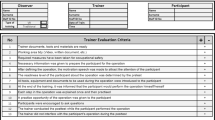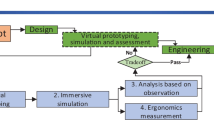Abstract
Factories and plants increasingly employ virtual reality (VR) for training, focusing on the optimization of workers’ movements based on ergonomics. This study investigates the impact of sense of embodiment (SoE) in a virtual workspace on workers’ task performance to elucidate SoE’s role as a performance measure in such environments. Participants, tasked with assembling an office chair consisting of eight parts using VR controllers, were observed. The results revealed that participants had difficulty perceiving the distance between parts, leading to difficulty in picking up parts. Therefore, it was concluded that the sense of self-location (SoSL) component of SoE influences assembly tasks in virtual workspaces. Additionally, we reveal how differences in SoE affect skill acquisition and subsequent real-word tasks, using brick stacking as an example. SoE was assessed through responses to fourteen questions rated on a 7-point scale. Higher SoE corresponded to faster skill acquisition, with participants displaying increased confidence and focus in the real workspace following high SoE conditions. This study revealed that SoE influences assembly tasks in virtual workspaces. Furthermore, it became evident that training in virtual workspaces with higher SoE leads to smoother operations in real workspaces. Thus, SoE serves as an important metric for task performance.
Access this chapter
Tax calculation will be finalised at checkout
Purchases are for personal use only
Similar content being viewed by others
References
Audi uses modular solution for virtual-reality training, Audi MediaCenter. (https://www.audi-mediacenter.com/en/press-releases/audi-uses-modular-solution-for-virtual-reality-training-10767)
BMW Group uses virtual reality engineering in its vehicle development, BMW. (https://www.bmw.com/en/events/nextgen/global-collaboration.html)
FLAIM TrainerTM, the world’s first immersive technology enables firefighter training solution, Flaim. (https://flaimsystems.com/products/trainer)
Using Hybrid Reality to Explore Scientific Exploration Scenarios, NASA. (https://nvite.jsc.nasa.gov/presentations/b3/D2_2_Virtual_Reality_Panel_Young.pdf)
Kobayashi, D., et al.: Effect of artificial haptic characteristics on virtual reality performance. In: Yamamoto, S., Mori, H., (eds.) HCII 2019, LNCS, vol. 11570, pp. 24–35. Springer Nature, Switzerland (2019)
Bagher, M.M., Sajjadi, P., Wallgrün, J.O., LaFemina, P., Klippel, A.: Virtual reality for geospatial education: immersive technologies enhance sense of embodiment. Cartography Geogr. Inf. Sci. 50(3), 233–248 (2023)
Otono, R.,et al.: I’m transforming! effects of visual transitions to change of avatar on the sense of embodiment in AR. In: 2023 IEEE Conference Virtual Reality and 3D User Interfaces (VR) (2023)
Subjective Fatigue Feelings, Working Group for Occupational Fatigue of Japan Society for Occupational Health. (https://square.umin.ac.jp/of/service.html)
Sasaki, T., Matsumoto, S.: Actual conditions of work, fatigue and sleep in non-employed, home-base female information technology workers with preschool children. Ind. Health 43, 142–150 (2005)
Matsumura, T., et al.: Fundamental study on fatigue measurement in VDT work from speech analysis. Electron. Commun. Jpn. 102(1), 10–17 (2018)
Brief Job Stress Questionnaire, Ministry of Health, Labor and Welfare. (https://www.mhlw.go.jp/bunya/roudoukijun/anzeneisei12/dl/stress-check_j.pdf)
Hart, S.G., Staveland, L.E.: Development of NASA-TLX (Task Load Index): results of empirical and theoretical research. Adv. Psychol. 52, 139–183 (1988)
Ishimura, I.: Psychological study on enhancing factors and positive functions of flow experiences. doctoral thesis from the School of Comprehensive Human Sciences, University of Tsukuba (2008). (in Japanese)
Jackson, S.A., Marsh, H.W.: Development and validation of a scale to measure optimal experience: the flow state scale. J. Sport Exerc. Psychol. 18, 17–35 (1996)
Kilteni, K., Groten, R., Slater, M.: The sense of embodiment in virtual reality. Presence Teleoperators Virtual Environ. 21(4), 373–387 (2012)
Gonzalez-Franco, M., Peck, T.C.: Avatar embodiment. towards a standardized questionnaire. Front. Robot. AI 5(74) (2018)
Author information
Authors and Affiliations
Corresponding authors
Editor information
Editors and Affiliations
Rights and permissions
Copyright information
© 2025 The Author(s), under exclusive license to Springer Nature Switzerland AG
About this paper
Cite this paper
Fukuda, R., Kuwata, N., Kobayashi, D. (2025). Improving Virtual Workspaces Based on Sense of Embodiment. In: Chen, J.Y.C., Fragomeni, G., Streitz, N.A., Konomi, S., Fang, X. (eds) HCI International 2024 – Late Breaking Papers. HCII 2024. Lecture Notes in Computer Science, vol 15377. Springer, Cham. https://doi.org/10.1007/978-3-031-76812-5_4
Download citation
DOI: https://doi.org/10.1007/978-3-031-76812-5_4
Published:
Publisher Name: Springer, Cham
Print ISBN: 978-3-031-76811-8
Online ISBN: 978-3-031-76812-5
eBook Packages: Computer ScienceComputer Science (R0)




